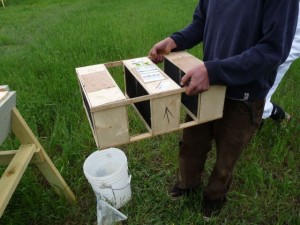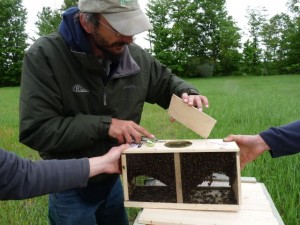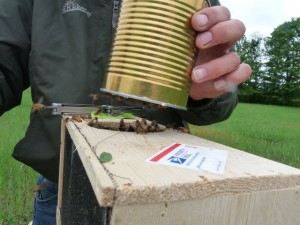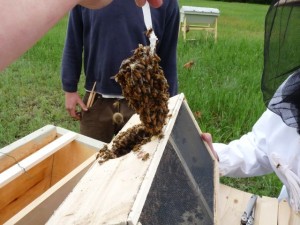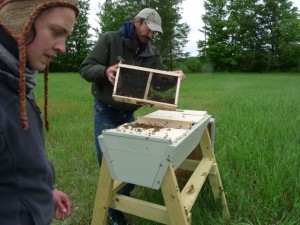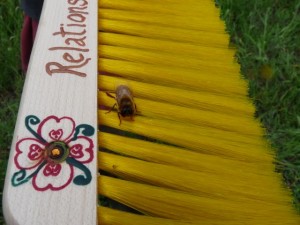The US Postal Service does work on Sundays, at least at the sorting stations. I got a call at 8 AM last Sunday informing me that the six packages of bees I had ordered could be picked up any time. I jotted down directions an excitedly hit the road to pick them up.
Package bees consist of a newly mated queen and an assortment of worker bees from established colonies. Generally, packages are sold in 2 pound (2#) and 3# packages, with about 5,000 bees per pound.
Ironically,  on the way home from the postal facility, I was driving behind a truck from a local apiary relocating Langstroth hives for pollination services (perhaps returning from a southerly state with the hives). This made the 90,000 bees in my VW seem a paltry number.
on the way home from the postal facility, I was driving behind a truck from a local apiary relocating Langstroth hives for pollination services (perhaps returning from a southerly state with the hives). This made the 90,000 bees in my VW seem a paltry number.
It was a cool (mid 40s F), windy morning, so I kept the packages in the car with the windows slightly cracked, to keep the bees warm and out of the wind, while assembling the crew and preparing for the installation. The work crew was all inexperienced in working with package bees and looking forward to installing them in the new hives.
The honey bee packages came as two parcels consisting of three packages held together in a thin wooden frame. The first step is to disconnect each package from the frame, by prying out the staples. One package goes into each hive.
The next step is to remove the wooden cover over the feeding can in the package, which allows the feeding can to be removed. A plastic strip next to the feeding can is attached to the queen cage. This allows it to be removed and hung from the first top bar in the hive. A wire is usually used to hang the queen cage from the top bar.
By the fifth package installation, we had a pretty good idea of what we were doing. And what not to do. Be very slow and careful in removing the feeding can and queen cage.
Some packages had quite a bit of wax and propolis holding the can and/or cage in place. Use a hive tool to carefully pry up the food can, remove it gently, and use the tool to loosen any propolis and wax around the queen cage before removing the cage, to avoid disturbing the bees.
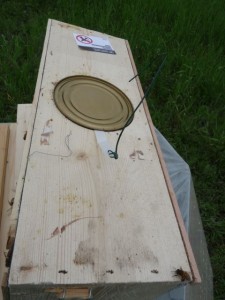
An opened package, showing the top of the feeding can and the strap for the queen cage, with wire attached
A hole can be put into the strap holding the queen cage, and a wire inserted, before removing the feeding can. This can make attaching the queen cage to a top bar a bit faster and less disruptive to the bees.
Probably in large part to the cool temperatures, we ended up cutting through the mesh on one side of the packages to completely dump the remaining bees into the hive. Initially, we placed the partly emptied packages in the back of the hives, behind the feeding area, hoping the bees would leave the package themselves. When we checked after about 30 minutes, there were still lots of bees in the packages, so out came my knife.
As there was still a fair amount of feeding solution in the cans, we decided to put them in the hives in addition to the zippered bags filled with 2:1 sugar solution I had prepared. Cans were placed on scraps from the shipping frames set “log cabin” style. Zippered bags were pierced several times with a knife to make small holes for the bees to access the sugar solution.
Two packages got fairly to moderately agitated when the can and queen cage were accidentally removed with too much force, shaking the package and dislodging bees. Packages where we were able to very carefully and slowly remove the feeding can and the cage were much, much less agitated and aggressive.
I was stung 3 times (2 of which were due to not wearing a veil — yes, I got stung on each cheek), two from disrupted packages, and one from a bee that got crushed on my wrist by my jacket cuff. I am not very allergic to bee and wasp stings, so I was not concerned about them, but I did put on my veil and cinch up my jacket cuffs, after the stings.
Had I suited up properly in the first place, I would not have been stung. Chewed plantain (Plantago species) leaves was the remedy of choice to treat the stings. Chewed leaves were applied to the stings. A visitor also had an excellent herbal salve made from plantain that I used.
There were drones included in the packages. Drones do not take part in work in the colony. Instead, their only function is reproduction.
Drones congregate together in the air, hoping to find virgin queens on their first (and only) mating flight. Once a queen returns to the hive, she will continue to lay eggs from this mating flight for her entire life.
The next chores with the hives are to check the sugar solution and replenish as needed, until the natural honey plants are blooming in full force. We will also check to make sure newly built comb is being put onto the top bars in straight lines. And on the 3rd day after installation, we will check the queen cages to ensure that the queen has been released by the colony (her cage is plugged with a sugar candy plug the bees can eat through.)
Let bee fever spread far and wide!

